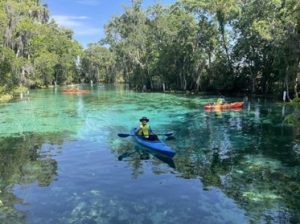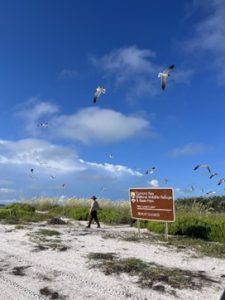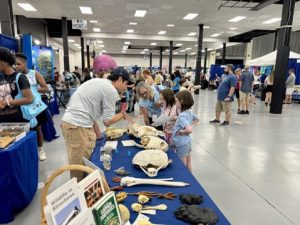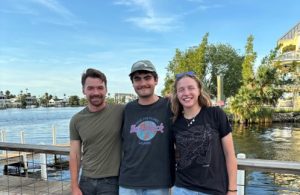Written by Alex Palvik, 2024 undergraduate summer intern hosted by Joyce Palmer at Crystal River National Wildlife Refuge Complex

This summer, I had the privilege to intern with the U.S. Fish and Wildlife Service at the Crystal River National Wildlife Refuge Complex under the management of refuge manager Joyce Palmer. During my time at the refuge, I learned invaluable skills and understood what it takes to run and manage a refuge complex behind the scenes through a variety of tasks and spontaneous adventures.

Manatee Mania
The Crystal River NWR is the only national wildlife refuge created for the protection of the Florida manatee and its habitat. The refuge is in charge of managing multiple natural springs in Crystal River, which are vital warm water habitats for the manatee. One of the pleasures of working at this refuge is the ability to go on manatee watch on slow days. On manatee watch I was responsible for patrolling the various springs in King’s Bay via kayak, ensuring that swimmers are interacting with manatees appropriately, educating the public about manatees, and enforcing proper recreational use of the springs. It was such a cool experience to be able to spend hours up-close with manatees and getting to explore the beautiful springs and islands scattered around King’s Bay.
Another responsibility that comes with working at this refuge is responding to public reports of potentially injured or dead manatees, which involves taking out a boat or putting on a wetsuit at a moment’s notice. I was lucky enough to help respond to some of these reports which included searching for a manatee carcass in one of the springs, as well as discovering a manatee placenta in another. From these experiences, I quickly learned the importance of adaptability and flexibility in this field.


Shorebird & Seabird Surveys
The Crystal River NWR Complex spans from the springs in King’s Bay all the way to the islands of Tampa Bay. One of my duties as an intern was to assist with nesting shorebird and seabird surveys at Egmont Key NWR in the Tampa Bay with refuge biologist Alex Arrow. This island, which is only accessible by boat, is home to one of the largest nesting sites for Laughing Gulls and Royal Terns in Florida. Through this experience I gained first-hand experience in the field conducting bird surveys, counting over 6,000 birds in a single survey window. I also strengthened my skills in shorebird and seabird identification and data sheet organization.
Seeing the colonies of thousands of nesting birds and their chicks was truly a sight like no other and it will be something I will never forget. Being able to stay the night on the island in a bunkhouse and explore the refuge when no one else is there felt like a once in a lifetime experience and definitely made it my favorite part of this internship.

Environmental Education
With a background and passion for environmental education, I got to assist the refuge with various environmental education programs and field trips. I helped teach local K-6 Students on manatee biology and wetland ecology, as well as create new lesson plans for future events. I even got to attend Shark Con in Tampa and staff an outreach table for the refuge, interacting with over a thousand attendees and educating the public about the refuge.
In the Office
When I wasn’t in the field or teaching a program, I assisted with the random tasks that come with managing a wildlife refuge. I conducted weekly eastern bluebird nest surveys, helped put manatee speed zone buoys in the bay, analyzed trail cam footage for a spring carrying capacity study, and more. I also attended weekly staff meetings where I gained an understanding for the financials of a NWR and learned about the history of the refuge. Being in this office setting has allowed me to gain important skills for my pre-professional career and enlightened me on the behind the scenes work that goes into managing a refuge.

Conclusion
This internship opportunity has been one of the highlights of my college experience so far. It has fueled my passion for wildlife ecology and conservation as well as equipped me with a skill set that will serve me well in my future endeavors. I want to thank everyone at NCBS and USFWS for making this summer an unforgettable experience. A special thanks to Alex Arrow, Emily Jung, Brier Ryver, and Joyce Palmer at Crystal River NWR for giving me the guidance and confidence to excel in this field.
| Follow the link to learn more about the UF/IFAS NCBS Undergraduate Summer Internship program. Read more intern blogs here. |
Featured image credit: UF/IFAS Photo by Tyler Jones
 0
0
